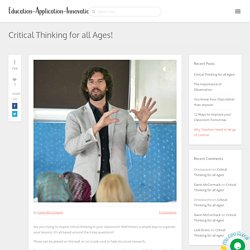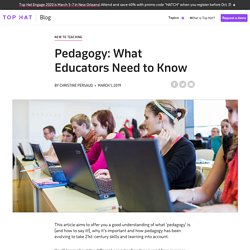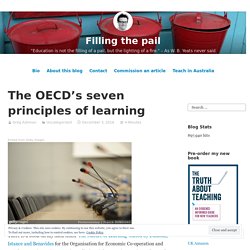

Future Driven Resources.pdf. Circle Up for a Better Climate and Culture. Holding a circle is a great tool to build community, climate, and culture.

Circles can provide intentionality to building social and emotional skills. We have seen circles work in K-12 classrooms, at staff meetings, in places of business, and more. If students or staff feel like they are valued, they are less likely to act out and more likely to maintain a positive environment. While doing a professional development session about our book, Hacking School Discipline, we practiced doing circles with the school staff at Liberty School in Orland Park, Illinois.
While doing circles in groups around the room, the staff had many great discussions that centered around chosen prompts that they developed. Critical Thinking for all Ages! – Gavin McCormack. Are you trying to inspire critical thinking in your classroom?

Well there’s a simple way to organise your lessons. It’s all based around the 6 key questions? These can be placed on the wall, or on a task card to help structure research. Pedagogy: What Educators Need to Know. This article aims to offer you a good understanding of what ‘pedagogy’ is (and how to say it!)

, why it’s important and how pedagogy has been evolving to take 21st-century skills and learning into account. You’ll learn about the different aspects of pedagogy and four common forms of pedagogy: social, critical, culturally responsive and Socratic. Examples for each will provide greater insight into how you can apply different pedagogical teaching styles to your own classroom. With tips on creating your own pedagogy, including taking into account how digital technology, online and collaborative work is changing teaching, you’ll understand why and how having a clear and concise pedagogy can support your curriculum. We’ll also touch on how new methods of teaching like flipped classrooms and blended learning can play into the pedagogical process.
Table of contents 1. 1. Pedagogy is often confused with curriculum. Recognising Authentic Context in Digital Technologies. Picture books with mathematical content. The visual elements of a quality picture book can illustrate a concept in ways it may be hard to do with other resources. For example, the pictures of a hundred ants marching in different arrays as they try to pick up some speed to reach the picnic (see One Hundred Hungry Ants by Elinor J. Princzes) can be difficult to organise on the mat!
The use of a narrative supports problem solving as students have a reason within the story to solve and to figure. Thinking Through Pedagogy for Primary and Early Years - Tony Eaude. Chalk Talk - THINKING PATHWAYS. Thinking Pathways Blog - THINKING PATHWAYS. Te Whariki Whakatauki. Learning spaces – Different spaces and their purposes / Innovative learning environments / Teaching. Director of innovation, Stephen Collis (Sydney Centre of Innovation in Learning) explains Professor David Thornburg's terms cave, campfire, and watering hole, and the different functions of these spaces in your learning environment.

Stephen describes how these functions can occur in a virtual space as well as a physical space. Professor David Thornburg, about 25 years ago actually, came up with three very interesting terms to help us decode different functions that can be occurring in a learning environment. Those three terms are cave, campfire and watering hole. I have found them very powerful, partly because the way he defines them really puts relationships at the heart of their definition. A campfire, the relationship is one-to-many and it’s a space where expertise is delivered or broadcast out from the guru. 2019 » CORE Education. Student-Centered Learning: Building Agency and Engagement. Edutopia.
There are plenty of studies that isolate the effects of light, acoustics, or air quality on learning. But the research on flexible classrooms is frustratingly scarce. There are good reasons for the apparent lack of interest. Variables like natural light and acoustics lend themselves to single-factor experiments that can be conducted in a laboratory setting. Give subjects a task to complete in a room with ample windows, for example, and then administer the same test in a room without them.
But flexible classrooms are complex, living systems. Despite the challenges, an ambitious effort to study the design of lived-in classrooms, including looking at hard-to-define factors like flexibility, was completed in 2015 by the University of Salford, in the United Kingdom. “We were trying to take a holistic perspective,” explained Peter Barrett, the lead researcher and now an honorary research fellow at the University of Oxford.
The Findings The big insight? Form, Function, and Flexibility. The OECD’s seven principles of learning. There is a book on my shelf titled ‘The Nature of Learning’ edited by Dumont, Istance and Benavides for the Organisation for Economic Co-operation and Development (OECD).

I sometimes dip into it because it contains a chapter by Dylan Wiliam on formative assessment that is a good summary of the arguments that he makes at length in his own books. There are also some chapters that I am less impressed with. For instance, there is a chapter on inquiry learning that doesn’t really mention the criticism that has been leveled at the approach. In the final section, the editors summarise seven key conclusions that they have drawn from the different chapters. The Science of Learning. 50300814. Thinking Through Pedagogy for Primary and Early Years - Tony Eaude.